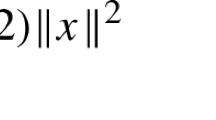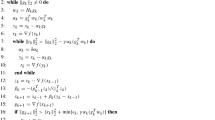Abstract
We consider extrapolated projection methods for solving linear feasibility problems. Both successive and sequential methods of a two-set projection scheme are examined. The best algorithm in the class of algorithms that we considered was an extrapolated sequential method. When this was compared to an interior point method using the CUTEr/Netlib linear programming test problems it was found that the bi-projection method was fastest (or equal fastest) for 31% of the cases, while the interior point code was fastest in 71% of the cases. The interior-point method succeeded on all examples, but the best bi-projection method considered here failed to solve 37% of the problems within reasonable CPU time or iteration thresholds.
Similar content being viewed by others
References
Bauschke, H.H., Combettes, P.L., Kruk, S.G.: Extrapolation algorithm for affine-convex feasibility problems. Numer. Algorithms 41(3), 239–274 (2006)
Censor, Y., Chen, W., Combettes, P.L., Davidi, R., Herman, G.T.: On the effectiveness of projection methods for convex feasibility problems with linear inequality constraints. Comput. Optim. Appl. (2011). doi:10.1007/s10589-011-9401-7
Combettes, P.L.: Hilbertian convex feasibility problem: Convergence of projection methods. Appl. Math. 35(3), 311–330 (1997)
Davis, T.A., Hager, W.W.: Dual multilevel optimization. Math. Program. 112(2), 403–425 (2008)
Davis, T.A., Hager, W.W.: A sparse proximal implementation of the lp dual active set algorithm. Math. Program. 112(2), 275–301 (2008)
Dolan, E.D., Moré, J.J.: Benchmarking optimization software with performance profiles. Math. Program. 91(2), 201–213 (2002)
Gould, N.I.M.: How good are projection methods for convex feasibility problems? Comput. Optim. Appl. 40(1), 1–12 (2008)
Gould, N.I.M., Orban, D., Toint, Ph.L.: CUTEr (and SifDec), a Constrained and Unconstrained Testing Environment, revisited. ACM Trans. Math. Softw. 29(4), 373–394 (2003)
Gould, N.I.M., Orban, D., Toint, Ph.L.: GALAHAD—a library of thread-safe fortran 90 packages for large-scale nonlinear optimization. ACM Trans. Math. Softw. 29(4), 353–372 (2003)
Pierra, G.: Decomposition through formalization in a product space. Math. Program. 28(1), 96–115 (1984)
Author information
Authors and Affiliations
Corresponding author
Electronic Supplementary Material
Below is the link to the electronic supplementary material.
Rights and permissions
About this article
Cite this article
Gould, N.I.M. How good are extrapolated bi-projection methods for linear feasibility problems?. Comput Optim Appl 51, 1089–1095 (2012). https://doi.org/10.1007/s10589-011-9414-2
Received:
Published:
Issue Date:
DOI: https://doi.org/10.1007/s10589-011-9414-2




